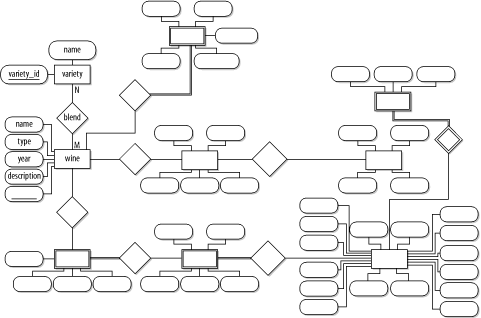The winestore entity-relationship model
Figure 3-3 shows the completed entity-relationship model for the online winestore derived from the system requirements listed in Chapter 1. Appendix C includes a description of the meaning of each shape and line type used in the figure.
Figure 3-3. The winestore ER model

The winestore model can be summarized as follows:
-
A customer at the online winestore purchases wines by placing one or more orders.
-
Each customer has exactly one set of user details.
-
Each order contains one or more items.
-
Each item is for a specific
quantityof wine at a specificprice. -
A wine is of a
typesuch as "Red," "White," or "Sparkling." -
A wine has a vintage
year; if the same wine has two or more vintages from different years, these are treated as two or more separate, distinct wines. -
Each wine is made by one winery.
-
Each winery is located in one region.
-
Each wine has one or more grape_variety entries. For example, a wine of
wine_name"Archibald" might be made of the grape_variety entries "Sauvignon" and "Cabernet." The order of the entries is important. For example, a "Cabernet Sauvignon" is different from a "Sauvignon Cabernet." -
Each wine may have one or more inventories.
-
Each inventory for a wine represents the on-hand stock of a wine that is available at a particular
costorcase_cost(a case is 12 bottles of wine). If a wine is available at two prices, there are two inventories.